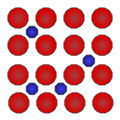General Chemistry/Metallic bonds
Review on structure
[edit | edit source]Atoms are particles composed of 3 subatomic particles. The protons, neutrons, and electrons. The protons and neutrons are in the nucleus and the electrons orbit this nucleus. These electrons can leave the atom and this is important to note especially for metals. The energy required to remove an electron is referred to as ionization energy and is very low for metals and so metals tend to lose their outermost (valence) electrons whenever possible. The attractive force between electrons and the nucleus is referred to as the electrostatic force of attraction. This electrostatic force is very strong and is capable of holding large structures together.
Overview
[edit | edit source]Metallic bonds occur among metal atoms. Whereas ionic bonds join metals to non-metals, metallic bonding joins a bulk of metal atoms. A sheet of aluminium foil and a copper wire are both places where you can see metallic bonding in action.

When metallic bonds form, the s and p electrons delocalize. Instead of orbiting their atoms, they form a "sea of electrons" surrounding the positive metal ions. The electrons are free to move throughout the resulting network. The electrostatic force of attraction between this "sea of electrons" and the positive ions acts as a form of "glue" holding together the metallic structure.
Properties
[edit | edit source]The delocalized nature of the electrons explains a number of unique characteristics of metals:
| Metals are good conductors of electricity | The sea of electrons is free to flow, allowing electrical currents. |
| Metals are good conductors of heat | As heat energy is defined by the motion of particles, the sea of electrons provides an excellent medium for this kinetic energy to be transferred. |
| Metals are ductile (able to draw into wires) and malleable (able to be hammered into thin sheets) |
As the metal is deformed, local bonds are broken but quickly reformed in a new position. |
| Metals are gray and shiny | Photons (particles of light) cannot penetrate the metal, so they bounce off the sea of electrons. |
| Gold is yellow and copper is reddish-brown | There is actually an upper limit to the frequency that is reflected. It is too high to be visible in most metals, but not gold and copper. |
| Metals have very high melting and boiling points | Metallic bonding is very strong, so the atoms are reluctant to break apart into a liquid or gas. |
Reactivity and solubility
[edit | edit source]Nearly all metals are near completely insoluble in most solvents whether organic or inorganic. This is because the bonds between metals are exceedingly strong and solvents cannot dissolve the metal. However, if the metal undergoes a reaction and forms an ionic compound it can dissolve. Metals react when an electronegative substance attracts the electrons in the sea of electrons and the structure collapses without the force holding it together. Metals almost always form ionic compounds however on occasion they can participate in a form of covalent bonding. These compounds however, do not share any of the properties of metallic bonding. Furthermore, it is important to distinguish between a compound of a metal and an alloy.
Alloys
[edit | edit source]Metallic bonds can occur between different elements. A mixture of two or more metals is called an alloy. This is what differentiates alloys and compounds containing metals, as alloys are only mixtures. Depending on the size of the atoms being mixed, there are two different kinds of alloys that can form:
-
Substitutional alloy
-
Interstitial alloy
It is also worth note that substitutional/interstitial alloys can exist when there are more than 2 metals are involved in the formation of an alloy.
The resulting mixture will have a combination of the properties of both metals involved. Interstitial alloys tend to be (with exceptions) stronger than their component metals. This is because the particles of varying size tend to prevent the various layers in a metal from sliding over each other smoothly. An example of this would be the difference between bronze and its components copper and tin. Copper on its own is a softer metal unfit for use as a weapon, while bronze was widely used during the Bronze Age for swords and armour. Alloys can also have various other benefits such as corrosion resistance, torsional strength, and much more.

